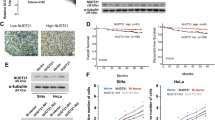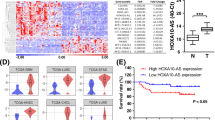Abstract
Widespread mRNA 3′ UTR shortening through alternative polyadenylation1 promotes tumor growth in vivo2. A prevailing hypothesis is that it induces proto-oncogene expression in cis through escaping microRNA-mediated repression. Here we report a surprising enrichment of 3′UTR shortening among transcripts that are predicted to act as competing-endogenous RNAs (ceRNAs) for tumor-suppressor genes. Our model-based analysis of the trans effect of 3′ UTR shortening (MAT3UTR) reveals a significant role in altering ceRNA expression. MAT3UTR predicts many trans-targets of 3′ UTR shortening, including PTEN, a crucial tumor-suppressor gene3 involved in ceRNA crosstalk4 with nine 3′UTR-shortening genes, including EPS15 and NFIA. Knockdown of NUDT21, a master 3′ UTR-shortening regulator2, represses tumor-suppressor genes such as PHF6 and LARP1 in trans in a miRNA-dependent manner. Together, the results of our analysis suggest a major role of 3′ UTR shortening in repressing tumor-suppressor genes in trans by disrupting ceRNA crosstalk, rather than inducing proto-oncogenes in cis.
This is a preview of subscription content, access via your institution
Access options
Access Nature and 54 other Nature Portfolio journals
Get Nature+, our best-value online-access subscription
$29.99 / 30 days
cancel any time
Subscribe to this journal
Receive 12 print issues and online access
$209.00 per year
only $17.42 per issue
Buy this article
- Purchase on Springer Link
- Instant access to full article PDF
Prices may be subject to local taxes which are calculated during checkout





Similar content being viewed by others
References
Xia, Z. et al. Dynamic analyses of alternative polyadenylation from RNA-Seq reveal landscape of 3′ UTR usage across 7 tumor types. Nat. Commun. 5, 5274, (2014).
Masamha, C. P. et al. CFIm25 links alternative polyadenylation to glioblastoma tumour suppression. Nature 510, 412–416 (2014).
Zhang, S. & Yu, D. PI(3)king apart PTEN’s role in cancer. Clin. Cancer Res. 16, 4325–4330 (2010).
Poliseno, L. et al. A coding-independent function of gene and pseudogene mRNAs regulates tumour biology. Nature 465, 1033–1038 (2010).
Mayr, C. & Bartel, D. P. Widespread shortening of 3′UTRs by alternative cleavage and polyadenylation activates oncogenes in cancer cells. Cell 138, 673–684 (2009).
Fu, Y. et al. Differential genome-wide profiling of tandem 3′ UTRs among human breast cancer and normal cells by high-throughput sequencing. Genome Res. 21, 741–747 (2011).
Lin, Y. et al. An in-depth map of polyadenylation sites in cancer. Nucleic Acids Res. 40, 8460–8471 (2012).
Morris, A. R. et al. Alternative cleavage and polyadenylation during colorectal cancer development. Clin. Cancer 18, 5256–5266 (2012).
Davoli, T. et al. Cumulative haploinsufficiency and triplosensitivity drive aneuploidy patterns and shape the cancer genome. Cell 155, 948–962 (2013).
Salmena, L., Poliseno, L., Tay, Y., Kats, L. & Pandolfi, P. P. A ceRNA hypothesis: the Rosetta Stone of a hidden RNA language? Cell 146, 353–358 (2011).
Thomson, D. W. & Dinger, M. E. Endogenous microRNA sponges: evidence and controversy. Nat. Rev. Genet. 17, 272–283 (2016).
Tay, Y. et al. Coding-independent regulation of the tumor suppressor PTEN by competing endogenous mRNAs. Cell 147, 344–357 (2011).
Sumazin, P. et al. An extensive microRNA-mediated network of RNA–RNA interactions regulates established oncogenic pathways in glioblastoma. Cell 147, 370–381 (2011).
Ala, U. et al. Integrated transcriptional and competitive endogenous RNA networks are cross-regulated in permissive molecular environments. Proc. Natl Acad. Sci. USA 110, 7154–7159 (2013).
Swanton, C. Intratumor heterogeneity: evolution through space and time. Cancer Res. 72, 4875–4882 (2012).
Lu, J. et al. MicroRNA expression profiles classify human cancers. Nature 435, 834–838 (2005).
Hausser, J. & Zavolan, M. Identification and consequences of miRNA–target interactions — beyond repression of gene expression. Nat. Rev. Genet. 15, 599–612 (2014).
Mets, E. et al. MicroRNA-128-3p is a novel oncomiR targeting PHF6 in T-cell acute lymphoblastic leukemia. Haematologica 99, 1326–1333 (2014).
Selcuklu, S. D. et al. MicroRNA-9 inhibition of cell proliferation and identification of novel miR-9 targets by transcriptome profiling in breast cancer cells. J. Biol. Chem. 287, 29516–29528 (2012).
Tian, B. & Manley, J. L. Alternative cleavage and polyadenylation: the long and short of it. Trends Biochem. Sci. 38, 312–320 (2013).
Mueller, A. A., Cheung, T. H. & Rando, T. A. All’s well that ends well: alternative polyadenylation and its implications for stem cell biology. Curr. Opin. Cell Biol. 25, 222–232 (2013).
Li, L. et al. 3′UTR shortening identifies high-risk cancers with targeted dysregulation of the ceRNA network. Sci. Rep. 4, 5406 (2014).
Tay, Y., Rinn, J. & Pandolfi, P. P. The multilayered complexity of ceRNA crosstalk and competition. Nature 505, 344–352 (2014).
Wang, Y. et al. The emerging function and mechanism of ceRNAs in cancer. Trends Genet. 32, 211–224 (2016).
Lewis, B. P., Burge, C. B. & Bartel, D. P. Conserved seed pairing, often flanked by adenosines, indicates that thousands of human genes are microRNA targets. Cell 120, 15–20 (2005).
Papadopoulos, G. L., Reczko, M., Simossis, V. A., Sethupathy, P. & Hatzigeorgiou, A. G. The database of experimentally supported targets: a functional update of TarBase. Nucleic Acids Res. 37, D155–D158 (2009).
Xiao, F. et al. miRecords: an integrated resource for microRNA–target interactions. Nucleic Acids Res. 37, D105–D110 (2009).
Hsu, S.-D. et al. miRTarBase update 2014: an information resource for experimentally validated miRNA–target interactions. Nucleic Acids Res. 42, D78–D85 (2014).
Dvinge, H. et al. The shaping and functional consequences of the microRNA landscape in breast cancer. Nature 497, 378–382 (2013).
Hamilton, M. P. et al. Identification of a pan-cancer oncogenic microRNA superfamily anchored by a central core seed motif. Nat. Commun. 4, 2730 (2013).
Goldman, M. et al. The UCSC Cancer Genomics Browser: update 2013. Nucleic Acids Res. 41, D949–D954 (2013).
Friedman, J. M., Hastie, T. & Tibshirani, R. Regularization paths for generalized linear models via coordinate descent. J. Stat. Softw. 33, 1–22 (2010).
Kim, S., Baladandayuthapani, V. & Lee, J. J. Prediction-oriented marker selection (PROMISE): with application to high-dimensional regression. Stat. Biosci 9, 217–245 (2016).
Bayerlová, M. et al. Newly constructed network models of different WNT signaling cascades applied to breast cancer expression data. PLoS ONE 10, 1–19 (2015).
Robinson, M. D., McCarthy, D. J. & Smyth, G. K. edgeR: a Bioconductor package for differential expression analysis of digital gene expression data. Bioinformatics 26, 139–140 (2010).
Trapnell, C. et al. Differential gene and transcript expression analysis of RNA-seq experiments with TopHat and Cufflinks. Nat. Protoc. 7, 562–578 (2012).
Krutzfeldt, J. et al. Silencing of microRNAs in vivo with ‘antagomirs’. Nature 438, 685–689 (2005).
Tenenbaum, S. A., Lager, P. J., Carson, C. C. & Keene, J. D. Ribonomics: identifying mRNA subsets in mRNP complexes using antibodies to RNA-binding proteins and genomic arrays. Methods 26, 191–198 (2002).
Acknowledgements
This work was supported by US National Institutes of Health (NIH) grants R01HG007538, R01CA193466 and U54CA217297, Cancer Prevention Research Institute of Texas (CPRIT) grant RP150292 to W.L., CPRIT RP100107 to E.J.W. and A.-B.S., CPRIT RP140800 and Welch Foundation AU-1889 to E.J.W., and NIH RO1GM046454 and the Houston Endowment, Inc. to A.-B.S.
Author information
Authors and Affiliations
Contributions
H.J.P. and W.L. conceived the project, designed the experiments and performed the data analysis. S.K. performed the regression analysis. Z.X. performed the APA analysis. L.L., J.S. and K.C. helped with data analysis. C.P.M., E.J.W. and A.-B.S. obtained the miRNA-Seq data. P.J., C.R.F.-G. and D.B. performed the NUDT21-knockdown experiments. H.J.P., P.J., E.J.W. and W.L. wrote the manuscript with input from B.R., A.-B.S., C.P.M. and J.R.N.
Corresponding authors
Ethics declarations
Competing interests
The authors declare no competing interests.
Additional information
Publisher’s note: Springer Nature remains neutral with regard to jurisdictional claims in published maps and institutional affiliations.
Integrated supplementary information
Supplementary Figure 1 3′UTR-shortening trans effect is associated with 3′UTR-shortening, but not with methylation changes.
(a) Scatter plot showing anti-correlation between ceRNA gene expression change in tumors (Y-axis, tumor / normal) vs. degree of 3′UTR shortening in tumors (X-axis, ΔPDUI normal - tumor) of the associated 3′UTR-shortening genes. Methylation level change (tumor vs. normal) on promoter regions (±1 Kbp from TSS) of (b) 158 3′US ceRNA tumor suppressors and the same number of sample control tumor suppressors and (c) PTEN on the 5 randomly-selected tumor normal pairs in More 3′US and Less 3′US groups (defined in Fig. 3d). Statistical significance is estimated from t-test.
Supplementary Figure 2 Sequence features of 3′UTRs of 500 tumor suppressors and their 3′US ceRNAs (381).
(a). 3′UTR lengths, (b) their phastCons score based on alignments of 45 vertebrate genomes with Human (the smaller, the faster it evolves15), and (c) the number of putative polyA motifs16 in the 3′UTRs. Statistical significance is estimated from t-test.
Supplementary Figure 3 MAT3UTR performance analysis.
(a). Transcript X has a constituitive proximal 3′-UTR (pUTR) and a distal 3′-UTR that might be shortened in tumors (dUTR) (b). X is a set of 3′US genes that are ceRNA partners of y′, and Y is a set of ceRNA partners to X. The edge represents ceRNA crosstalk. Note that this model is implicitly dependent on y′, since X and Y are defined on the basis of y′. Observed gene expression changes (tumor/normal) vs. MAT3UTR model scores (c) and MAT3UTR-control model score (d). Correlation (e) and mean square error (f) of MAT3UTR model scores based on 100 runs of 10-fold cross validation, when the model is learned from the ridge regression and classical linear regression. (g) Observed PTEN expression change (tumor/normal) vs. MAT3UTR score for each tumor/normal pair.
Supplementary Figure 4 AGO2 and DICER expression in NUDT21 KD HeLa cell.
Detection of AGO2 associated genes in HeLa cells by real time PCR (a) RNA-binding protein immunoprecipitation (RIP) was performed with AGO2 antibody, normal mouse IgG was served as a control. The RIP complex was detected by western blot with another AGO2 antibody from Rat. (b) AGO2 associated genes were measured by real time PCR. Two candidate ceRNAs, PHF6 and LARP1, and LAMC1 3′UTR shortening gene were enriched up to 229.5, 343.6 and 232.1 fold. FOS was served as a positive control and 7SK snRNA as a negative control. (c) Dicer1 expression level in Ctrl and NUDT21 KD HeLa cells (d) Scatterplot showing miRNA expression levels in Ctrl or NUDT21 KD HeLa cells, where black lines indicate differentially expressed miRNAs (2-fold up or down).
Supplementary Figure 5 Knock down of PHF6 and LARP1 increase cell growth.
PHF6 and LARP1 was reduced by siRNAs (a) and led to increase cell growth (b). In (b), the sample size is triplicate for each time point and two-sided T- test was used to calculate the p-values.
Supplementary information
Supplementary Text and Figures
Supplementary Figures 1–5 and Supplementary Note
Supplementary Table 1
Tab 3US ceRNA hub contains 591 ceRNA partners of 3′ UTR–shortening genes in TCGA breast cancer data that are connected to more than 500 genes in the normal ceRNET
Supplementary Table 2
The MAT3UTR for BRCA tab contains information of 1,548 differentially expressed 3′ US ceRNA partners in breast tumor/normal ceRNETs; MAT3UTR score indicates predicted expression changes from the MAT3UTR model
Supplementary Table 3
The MAT3UTR for NUDT21 tab contains information on 57 tumor suppressors that are 3′ US ceRNA partners in wild-type and NUDT21 KD data; MAT3UTR score indicates predicted expression changes from MAT3UTR
Supplementary Table 4
The Coefs for MAT3UTR for NUDT21 tab contains β_miRj (coefficients) from eq. (3) (Methods) for each miRNA (miRj) and each gene (y′)
Supplementary Table 5
Primer sequences for RIP–qPCR
Rights and permissions
About this article
Cite this article
Park, H.J., Ji, P., Kim, S. et al. 3′ UTR shortening represses tumor-suppressor genes in trans by disrupting ceRNA crosstalk. Nat Genet 50, 783–789 (2018). https://doi.org/10.1038/s41588-018-0118-8
Received:
Accepted:
Published:
Issue Date:
DOI: https://doi.org/10.1038/s41588-018-0118-8
This article is cited by
-
RBBP6 maintains glioblastoma stem cells through CPSF3-dependent alternative polyadenylation
Cell Discovery (2024)
-
PABPN1 regulates mRNA alternative polyadenylation to inhibit bladder cancer progression
Cell & Bioscience (2023)
-
MiR-138 is a potent regulator of the heterogenous MYC transcript population in cancers
Oncogene (2022)
-
LINC00511/hsa-miR-573 axis-mediated high expression of Gasdermin C associates with dismal prognosis and tumor immune infiltration of breast cancer
Scientific Reports (2022)
-
Pan-cancer pervasive upregulation of 3′ UTR splicing drives tumourigenesis
Nature Cell Biology (2022)



